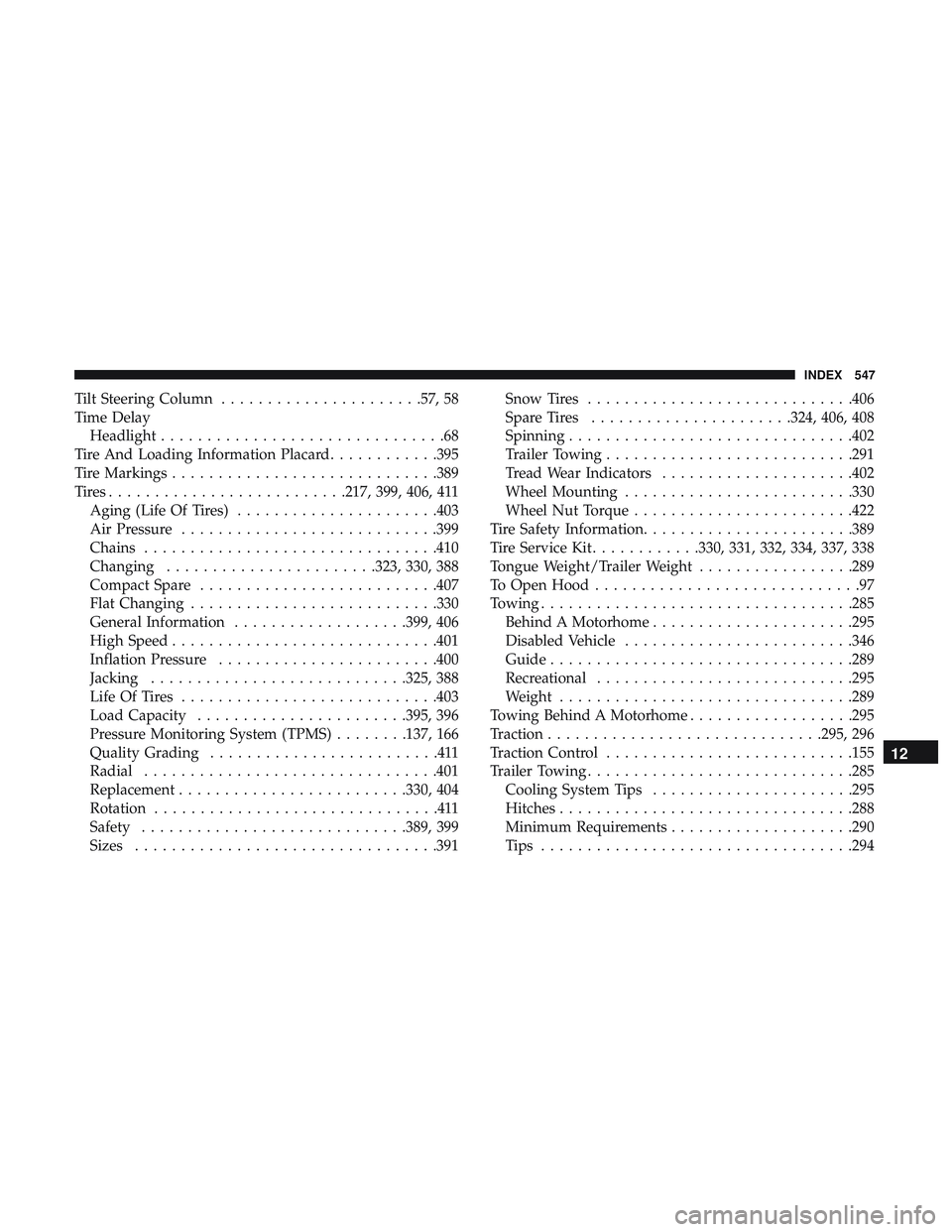Page 173 of 553

2. If you install the compact or non-matching full sizespare tire in place of a road tire that has a pressure below
the low-pressure warning limit, upon the next ignition
key cycle, the TPMS Warning Light will remain on and
a chime will sound. In addition, the graphic in the
instrument cluster will still display a different color
pressure value and an �Inflate to XX�message.
3. After driving the vehicle for up to 20 minutes above 15 mph (24 km/h), the TPMS Warning Light will flash
on and off for 75 seconds and then remain on solid. In
addition, the instrument cluster will display a “Service
Tire Pressure System” message for five seconds and then
display dashes (- -) in place of the pressure value.
4. For each subsequent ignition key cycle, a chime will sound, the TPMS Warning Light will flash on and off for
75 seconds and then remain on solid, and the instrument
cluster will display a “Service Tire Pressure System”
message for five seconds and then display dashes (- -) in
place of the pressure value.
5. Once you repair or replace the original road tire and reinstall it on the vehicle in place of the compact spare or
non-matching full size, the TPMS will update automati-
cally. In addition, the TPMS Warning Light will turn off
and the graphic in the instrument cluster will display a new pressure value instead of dashes (- -), as long as no
tire pressure is below the low-pressure warning limit in
any of the four active road tires. The vehicle may need to
be driven for up to 20 minutes above 15 mph (24 km/h)
in order for the TPMS to receive this information.
TPMS Deactivation — If Equipped
The Tire Pressure Monitoring System (TPMS) can be deac-
tivated if replacing all four wheel and tire assemblies (road
tires) with wheel and tire assemblies that do not have
TPMS Sensors, such as when installing winter wheel and
tire assemblies on your vehicle.
To deactivate the TPMS, first replace all four wheel and tire
assemblies (road tires) with tires not equipped with Tire
Pressure Monitoring (TPM) Sensors. Then, drive the ve-
hicle for 20 minutes above 15 mph (24 km/h). The TPMS
will chime, the TPMS Warning Light will flash on and off
for 75 seconds and then remain on. The instrument cluster
will display the “Service Tire Pressure System” message
and then display dashes (--) in place of the pressure values.
Beginning with the next ignition cycle, the TPMS will no
longer chime or display the “Service Tire Pressure System”
message in the instrument cluster but dashes (--) will
remain in place of the pressure values.5
SAFETY 171
Page 174 of 553

To reactivate the TPMS, replace all four wheel and tire
assemblies (road tires) with tires equipped with TPM
sensors. Then, drive the vehicle for up to 20 minutes above
15 mph (24 km/h). The TPMS will chime, the TPMS
Warning Light will flash on and off for 75 seconds and then
turn off. The instrument cluster will display the “Service
Tire Pressure System” message and then display pressure
values in place of the dashes. On the next ignition cycle the
�Service Tire Pressure System�message will no longer be
displayed as long as no system fault exists.
General Information
The following regulatory statement applies to all radio
frequency (RF) devices equipped in this vehicle:
This device complies with Part 15 of the FCC Rules and
with Industry Canada license-exempt RSS standard(s).
Operation is subject to the following two conditions:
(1) This device may not cause harmful interference, and
(2) This device must accept any interference received,
including interference that may cause undesired operation.
NOTE: Changes or modifications not expressly approved
by the party responsible for compliance could void the
user ’s authority to operate the equipment.
OCCUPANT RESTRAINT SYSTEMS
Some of the most important safety features in your vehicle
are the restraint systems:
Occupant Restraint Systems Features
• Seat Belt Systems
• Supplemental Restraint Systems (SRS) Air Bags
• Child Restraints
Some of the safety features described in this section may be
standard equipment on some models, or may be optional
equipment on others. If you are not sure, ask an authorized
dealer.
Important Safety Precautions
Please pay close attention to the information in this section.
It tells you how to use your restraint system properly, to
keep you and your passengers as safe as possible.
Here are some simple steps you can take to minimize the
risk of harm from a deploying air bag:
1. Children 12 years old and under should always ride buckled up in the rear seat of a vehicle with a rear seat.
172 SAFETY
Page 549 of 553

Tilt Steering Column..................... .57, 58
Time Delay Headlight ...............................68
Tire And Loading Information Placard ............395
Tire Markings ............................ .389
Tires..........................217, 399, 406, 411 Aging (Life Of Tires) ..................... .403
Air Pressure ............................399
Chains ............................... .410
Changing .......................323, 330, 388
Compact Spare ..........................407
Flat Changing .......................... .330
General Information ...................399, 406
High Speed ............................ .401
Inflation Pressure ........................400
Jacking ............................325, 388
Life Of Tires ............................403
Load Capacity .......................395, 396
Pressure Monitoring System (TPMS) ........137, 166
Quality Grading .........................411
Radial ............................... .401
Replacement ........................ .330, 404
Rotation ...............................411
Safety ............................ .389, 399
Sizes .................................391 Snow Tires
............................ .406
Spare Tires ..................... .324, 406, 408
Spinning ...............................402
Trailer Towing .......................... .291
Tread Wear Indicators .....................402
Wheel Mounting ........................ .330
Wheel Nut Torque ........................422
Tire Safety Information .......................389
Tire Service Kit ............330, 331, 332, 334, 337, 338
Tongue Weight/Trailer Weight .................289
To Open Hood .............................97
Towing ................................. .285
Behind A
Motorhome..................... .295
Disabled Vehicle ........................ .346
Guide .................................289
Recreational ............................295
Weight ............................... .289
Towing Behind A Motorhome ..................295
Traction ............................. .295, 296
Traction Control .......................... .155
Trailer Towing ............................ .285
Cooling System Tips ..................... .295
Hitches ............................... .288
Minimum Requirements ....................290
Tips ................................. .294
12
INDEX 547